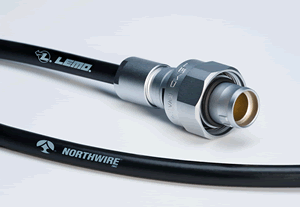Complex Underwater Connectivity Calls for Custom Solutions
Since more than 71% of the earth’s surface is covered by water, it’s no surprise it is responsible for an abundance of application failures. To ensure success, improve your risk assessment of off-the-shelf parts and learn how custom designs help navigate complex environmental factors.
 Sometimes focusing on hurdle rates, internal rate of return, and the short-sighted bottom line can lead to disaster. This is often the case when making “apples-to-oranges” comparisons. While engineered products can have a marginally higher price versus off-the-shelf parts and appear more attractive initially, it is vital to be aware of the longer-term hidden dangers of decision-making based on price alone. There are actually 29 cost factors to consider, including service quality, risk management, total landed cost, labor, training, and much more.
Sometimes focusing on hurdle rates, internal rate of return, and the short-sighted bottom line can lead to disaster. This is often the case when making “apples-to-oranges” comparisons. While engineered products can have a marginally higher price versus off-the-shelf parts and appear more attractive initially, it is vital to be aware of the longer-term hidden dangers of decision-making based on price alone. There are actually 29 cost factors to consider, including service quality, risk management, total landed cost, labor, training, and much more.
The importance of specifying products based upon quantitative critical-to-quality requirements cannot be overstressed. Price alone cannot be the deciding factor; decision-makers should evaluate subject matter expertise, domestic and international standards, agency compliance, environmental regulations, and electrical, mechanical, ergonomic, aesthetic, harsh duty, and end-user requirements, to name a few. This is especially true when the product is used in a harsh-environment application, such as underwater.
Expensive Lessons Learned
When it comes to spectacular displays and incredible entertainment, few places rival a casino. A huge amount of work goes into powering, programming, controlling, and maintaining the shows and attractions seen at these sites.
In 2011, a contractor at one of the world’s largest casinos contacted Northwire. One of the large underwater entertainment venues at the facility, a water theater housing a multimillion dollar production, experienced massive destruction due to an underwater cable system that failed to properly block water, which resulted in an equipment loss to the tune of $250,000.
The original cable assembly was designed to control and power water jets, lighting, moving platforms, and more as directed by a central control computer. When the system broke down, it was not only unsuccessful in stopping water leaks, but siphoned water back into the central control computers. In addition to the equipment damage, all operations had to be shut down in the venue.
As with this contractor, many project managers struggle to find reliable cable and connectors for underwater use. Another set of factors comes into play when mixing electronics and liquids, so precision, quality, and safety are of the utmost importance.
Fit vs. Function
From time to time a standard part is installed and operates without obvious problems. This short-term “fit” can have defects that are hard to detect, like inferior materials or manufacturing non-conformances. While not immediately noticeable, selecting products on “fit” alone increases the likelihood of early failure. Custom-engineered OEM solutions, on the other hand, are designed to meet exact product specifications, ensuring that both fit and function are achieved. Also, they are tested and field-proven to the identical application and subjected to their intended life cycle.
One Size Does Not Fit All
With the diverse range of underwater applications, there truly is no “one-size-fits-all” cable assembly system. When a customer comes to LEMO or Northwire with a project in mind, the goal is to find the most effective connector, cable, or cable assembly for that specific use.
Therefore, no off-the-shelf product is standardized for underwater applications. Instead, a customer will meet with a subject matter expert to discuss the challenges and requirements of each individual project. Working closely with the customer, the experts employ rapid prototyping and testing capabilities to design and manufacture each component to the customer’s needs.
Northwire met with the casino’s contractor and identified the root cause of the failure. Meanwhile, the team gathered all of the critical-to-quality requirements from key stakeholders. Then, NWI’s subject matter experts rapidly designed, tested, and prototyped a cable specifically for the venue’s rugged requirements. The custom cable system was tested to withstand 100 PSI (6.985 bar) and delivered high performance when fully submersed in chlorinated water. Reinforced tensile strength, abrasion resistance, and flexibility enabled the cable to wrap around concrete pylons while preserving signal integrity.
Solution-oriented and application-driven, the cable and connector design, engineering, and manufacturing processes are tailored for the individual project, giving customers a best-quality, highly effective, long-lasting system.
Critical-to-Quality Factors
When evaluating underwater cable systems, consider these critical-to-quality factors:
- Application: Underwater vision systems may require a fundamentally different type of cable than underwater lighting or monitoring and research applications.
- Compliance: Ratings, agency listings, government certifications, and environmental standards such as UL, ANSI, CSA, CE, IEEE, ABS, RoHS2, REACH, and 1,000-hour weatherometer requirement all need to be considered.
- Features: Signal, control, instrumentation, and power
- Water type: Different options exist for salt, fresh, brackish, chemical-treated, waste, and potable water. For example, cable in contact with potable water may need to be made of FDA-approved, food-grade materials.
- Cable depth: Cable systems at greater depths require heavy-duty materials and pressure resistance.
- Flex: Cold bend, torsional, rolling, variable, bend, and continuous flex options exist for cables whose applications require regular motion.
- Environment: Knowing whether a cable must function in an industrial pipe, ocean, or rocky riverbed determines many design factors.
- Temperatures: From Arctic to high rating, cable systems are designed for specific temperatures ranges.
- Buoyancy: Special considerations must be taken when a cable is required to have a negative, neutral, or positive buoyancy.
In response to his urgent request, the casino’s contractor had an effective, custom cable-and-connection solution on site within five days, saving the casino from further loss and downtime.
“The customer called late on Friday in need of an urgent solution,” explains a Northwire team member. “Our engineering team translated the customer’s critical-to-quality requirements into several designs, test and development protocols, and rapid prototypes. Results were reported to the customer the following business day. He selected one of several custom solutions. Two days later, our production team shipped his product.”
To read this white paper by Northwire and LEMO in its entirety, click here.
[hr]




